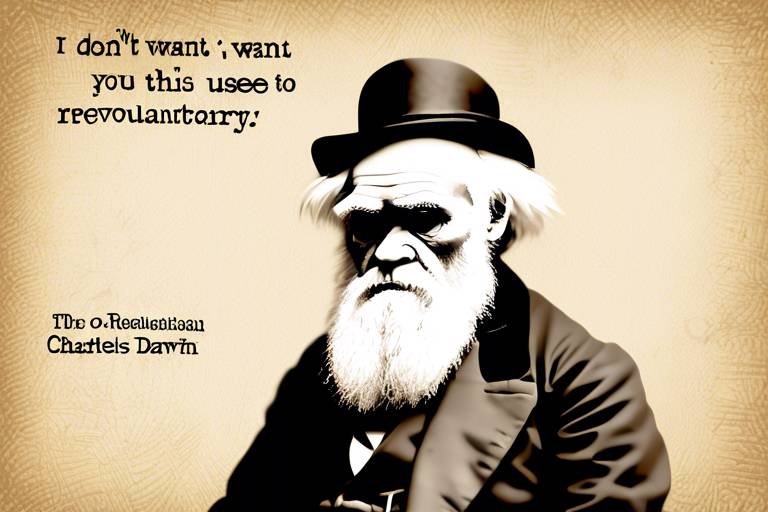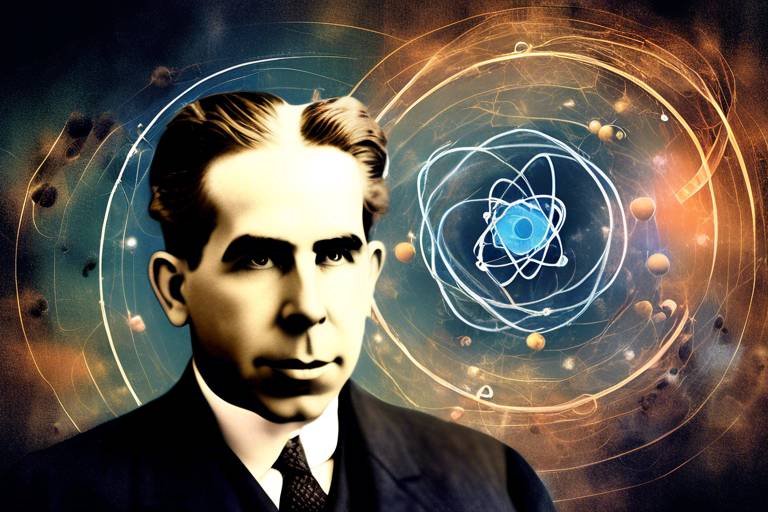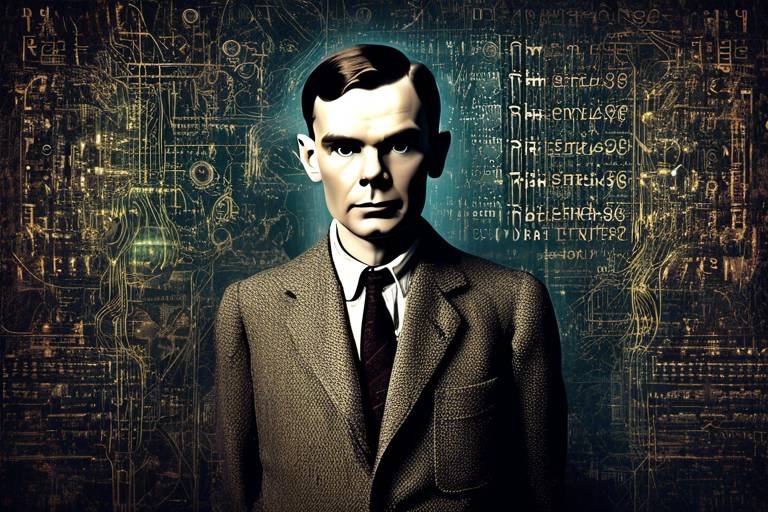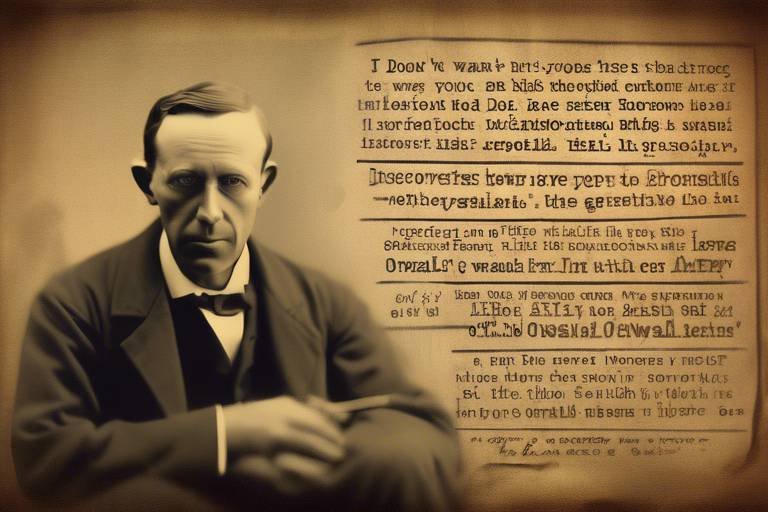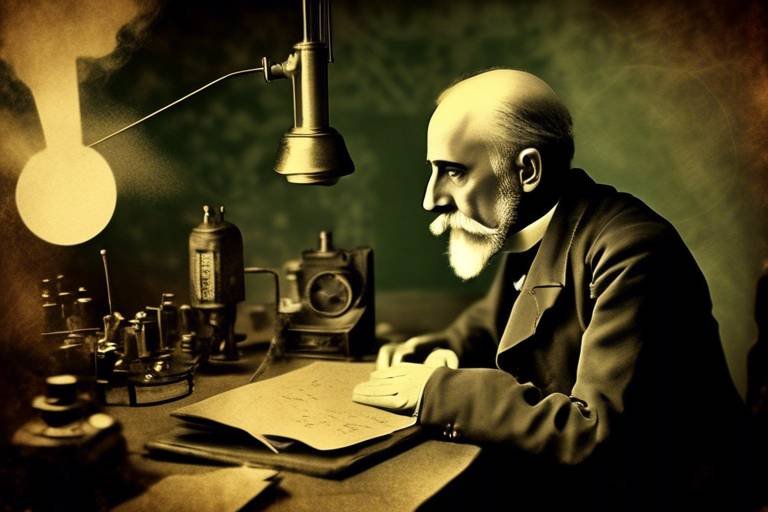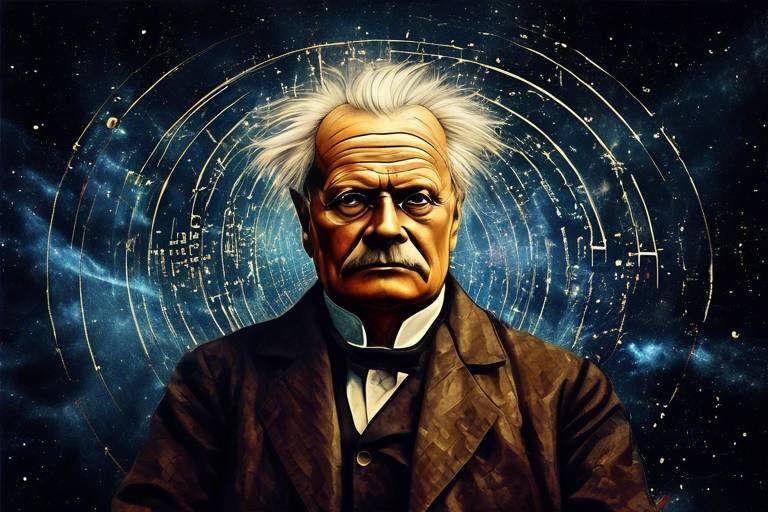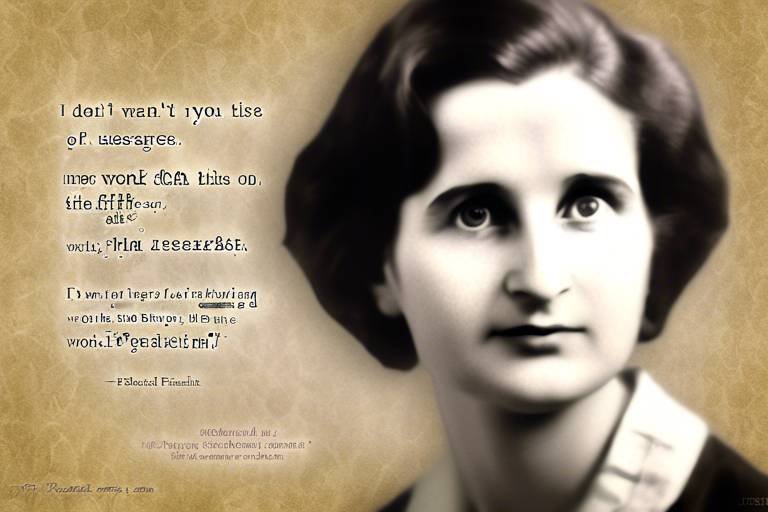The Revolutionary Ideas of Charles Darwin
Charles Darwin, a name synonymous with the concept of evolution, has woven a narrative that fundamentally reshaped our understanding of life on Earth. His groundbreaking theories, particularly those concerning evolution and natural selection, have not only influenced the realm of biology but have also sparked profound discussions across various disciplines, including philosophy, sociology, and even religion. Imagine a world where every living organism, from the tiniest microbe to the largest mammal, is part of a grand tapestry of life, constantly changing and adapting. This is the essence of Darwin's revolutionary ideas.
Darwin's journey began with a simple observation: species are not static; they evolve over time. This realization was akin to discovering a hidden door in a long-forgotten library, leading to an entirely new section of knowledge. His seminal work, The Origin of Species, published in 1859, laid the groundwork for understanding how species adapt to their environments through a process that is both beautiful and brutal—natural selection. It’s a concept that can be likened to a relentless game of survival, where only the most suited players thrive.
In essence, Darwin proposed that all species share a common ancestor and that the diversity of life we see today is the result of millions of years of gradual changes driven by environmental pressures. This idea was revolutionary, challenging the prevailing notions of creationism and fixed species. It opened the floodgates to a new way of thinking about life, one that embraces change and adaptability as fundamental characteristics of existence.
As we delve deeper into Darwin's theories, it becomes clear that they are not just confined to the realm of science; they ripple through the fabric of society. His ideas have ignited debates that question our understanding of humanity's role in the natural world. Are we merely products of chance, or do we possess a unique place in the grand scheme of life? These questions continue to provoke thought and discussion, illustrating the enduring impact of Darwin's work.
In the following sections, we will explore the intricacies of Darwin's theories, examining how natural selection operates, the significance of variation among species, and the profound implications of his ideas on modern science and society. Buckle up, because the journey through Darwin's revolutionary ideas is not just a stroll through history; it's an exhilarating ride through the very essence of life itself.

The Theory of Evolution
Charles Darwin's theory of evolution is nothing short of a revolutionary paradigm shift in our understanding of life on Earth. Imagine a world where every species, including humans, is not a static entity but a dynamic product of change over time. This idea challenges the very foundation of how we perceive living organisms and their origins. At its core, Darwin's theory posits that species evolve through a process called natural selection, where the traits that enhance survival and reproduction become more common in successive generations. This process is akin to a slow, yet relentless river carving its way through rock, shaping the landscape of life itself.
Before Darwin, the prevailing belief was that species were created in their current forms and remained unchanged. However, Darwin's observations during his voyage on the HMS Beagle led him to conclude that species adapt to their environments over time. He meticulously gathered evidence from various ecosystems, particularly from the Galápagos Islands, where he noted variations among finch species. These finches had different beak shapes, each suited to their particular diet and habitat. This observation was pivotal, illustrating that small changes could lead to significant differences, a concept that would lay the groundwork for modern evolutionary biology.
The implications of Darwin's theory extend far beyond biology. It invites us to reconsider our place in the universe. Are we merely the result of chance, or do we possess a unique role in the grand tapestry of life? This question resonates with many, prompting a deeper exploration of our origins and connections to other species. In essence, the theory of evolution provides a framework for understanding the diversity of life and the processes that drive it.
To further illustrate the concept of evolution, consider the following table that summarizes key components of Darwin's theory:
| Component | Description |
|---|---|
| Variation | Differences among individuals in a population, crucial for natural selection. |
| Inheritance | Traits are passed from parents to offspring, allowing advantageous traits to persist. |
| Overproduction | More offspring are produced than can survive, leading to competition for resources. |
| Natural Selection | The process where individuals with favorable traits are more likely to survive and reproduce. |
In summary, Darwin's theory of evolution is a cornerstone of modern science, reshaping our understanding of biology and the interconnectedness of life on Earth. It emphasizes that we are all part of a vast, evolving web of life, constantly adapting and changing. This revolutionary idea not only impacts scientific thought but also invites us to reflect on our relationship with nature and the responsibilities that come with it.

Natural Selection Explained
Natural selection is one of the most fascinating concepts in biology, and it serves as the engine driving the process of evolution. At its core, natural selection is all about survival and adaptation. Imagine a crowded marketplace where only the best vendors thrive. In nature, those vendors are the organisms that possess traits making them more suited to their environment. This idea fundamentally shifts our understanding of how life evolves over time, suggesting that it's not merely random chance but a process shaped by the environment and the survival of the fittest.
To put it simply, natural selection operates through a series of steps that can be summarized as follows:
- Variation: Within any given population, individuals exhibit variations in their traits. These differences can be physical, behavioral, or physiological.
- Competition: Resources such as food, water, and shelter are limited. This leads to competition among individuals.
- Survival: Those individuals with traits that give them an advantage in their environment are more likely to survive and reproduce.
- Reproduction: The successful individuals pass on their advantageous traits to their offspring, gradually changing the population over generations.
But what does this mean for the broader picture of life on Earth? It means that species are not static; they are constantly evolving. Think of it as a never-ending race where the finish line keeps moving. As environments change, so too do the challenges that species face. This dynamic nature of natural selection is why we see such incredible diversity in life forms, from the majestic giraffe with its long neck to the tiny hummingbird flitting from flower to flower.
One of the most intriguing aspects of natural selection is the role of genetic mutations. These mutations are random changes in an organism's DNA that can lead to new traits. Some mutations might be detrimental, while others could provide a significant advantage. For instance, a mutation that allows a plant to tolerate drought conditions could mean the difference between survival and extinction in a changing climate. This interplay of chance and necessity is what makes evolution such a captivating subject.
Moreover, the environment itself plays a critical role in shaping which traits are favored. Factors such as climate, food availability, and predation pressure can all influence the direction of natural selection. For example, in a colder environment, animals with thicker fur are more likely to survive than those with thinner coats. This leads to a gradual change in the population as those better adapted to the cold continue to thrive and reproduce.
In essence, natural selection is not just about individual survival; it's about the ongoing dance between organisms and their environments. It’s a powerful reminder that life is a complex web of interactions, where every change can ripple through the ecosystem. Understanding natural selection enriches our appreciation of the natural world and highlights the intricate processes that have shaped the diversity of life we see today.

Variation Among Species
Variation among species is one of the cornerstones of Darwin's theory of evolution. Imagine a vibrant garden filled with different types of flowers; each one has its unique color, shape, and scent. Similarly, in nature, variation is what makes each species distinct from one another. This diversity is essential for the process of natural selection to occur. Without variation, evolution would be stagnant, akin to a river that has run dry. It is through these variations that certain traits become more prevalent in a population, ultimately guiding the evolutionary journey of species.
To illustrate this point, consider the classic example of the peppered moth in England. Before the Industrial Revolution, the majority of these moths were light-colored, blending seamlessly with the lichen-covered trees they rested on. However, as soot and pollution darkened the environment, darker moths began to thrive because they were less visible to predators. This shift in the population highlights how variations in color, driven by environmental changes, can lead to significant evolutionary outcomes.
Moreover, variation is not just limited to physical traits. It can also encompass behavioral differences, such as feeding habits or mating rituals. For instance, some species of birds might develop unique songs or calls that allow them to attract mates more effectively. These behavioral variations can be just as crucial for survival and reproduction as physical traits.
One of the key sources of variation is genetic mutations. These mutations can introduce new traits into a population, some of which may provide advantages in a given environment. For example, a mutation might result in a longer beak for a bird, allowing it to access food sources that others cannot reach. Over time, such advantageous traits can become more common within the population, leading to evolutionary changes.
In addition to genetic mutations, environmental factors also play a significant role in shaping variation among species. Changes in climate, habitat, and food availability can influence which traits are favored in a population. For instance, a drought may favor plants with deeper roots, allowing them to access water more effectively. As these plants survive and reproduce, their advantageous traits become more widespread.
In summary, variation among species is not just a fascinating aspect of biology; it is a fundamental component of the evolutionary process. It allows for adaptability and resilience in changing environments, ensuring that life continues to thrive on our planet. As we explore the intricacies of evolution, we come to appreciate the rich tapestry of life, woven together by the threads of variation.

Genetic Mutations
Genetic mutations are fascinating phenomena that act as the raw material for evolution. Imagine a painter who, instead of using a brush, splashes paint on a canvas randomly. Some splashes create beautiful patterns, while others might just look like a mess. In the same way, genetic mutations introduce changes to the DNA sequence of organisms, leading to new traits that can have varying effects on the individual. These mutations can occur for several reasons, such as environmental factors, errors during cell division, or even exposure to radiation. It's like nature's way of experimenting, testing out new designs in the grand tapestry of life.
Not all mutations are created equal, though. Some mutations can be beneficial, providing an advantage in survival and reproduction. For instance, a mutation that allows a plant to tolerate drought conditions can lead to its thriving in arid environments where other plants might perish. Conversely, some mutations can be harmful, leading to diseases or disadvantages that hinder survival. Picture a deer with a mutation that makes it slower than its peers; this deer may struggle to escape predators and thus has a lower chance of passing on its genes.
Interestingly, the impact of a mutation can also depend on the environment. A trait that is advantageous in one setting might be detrimental in another. For example, a mutation that gives a lizard a bright color may attract mates in a lush, green forest but make it more visible to predators in a sandy desert. This highlights the dynamic relationship between genetics and the environment, showcasing how mutations can drive evolution in different directions based on external pressures.
To better understand the role of genetic mutations in evolution, consider the following types of mutations:
- Point Mutations: These are changes in a single nucleotide base, which can lead to significant changes in protein function.
- Insertions and Deletions: These mutations involve adding or removing nucleotide bases, potentially altering the entire reading frame of a gene.
- Duplications: This occurs when a section of DNA is duplicated, leading to multiple copies of a gene, which can result in new functions.
In summary, genetic mutations are not just random errors; they are essential components of the evolutionary process. They provide the variation upon which natural selection acts, shaping the future of species. Without these mutations, life as we know it would be stagnant, lacking the diversity that makes the natural world so vibrant and dynamic.
What are genetic mutations?
Genetic mutations are changes in the DNA sequence of an organism, which can lead to new traits and variations within a population.
Are all mutations harmful?
No, mutations can be beneficial, neutral, or harmful. Some mutations provide advantages that enhance survival, while others may lead to diseases or disadvantages.
How do mutations contribute to evolution?
Mutations introduce genetic diversity, which is essential for natural selection. Traits that confer advantages in a given environment are more likely to be passed on to future generations.
Can mutations be inherited?
Yes, mutations can be passed down from parents to offspring if they occur in the germ cells (sperm or eggs).

Environmental Influence
The environment is like a stage where the drama of evolution unfolds, influencing the characteristics that species develop over time. Imagine a world where the weather can dictate who thrives and who barely survives—this is the essence of natural selection. Environmental factors such as climate, food availability, and habitat play crucial roles in shaping the traits that become prevalent in a population. For instance, consider the classic example of the peppered moth in England. Before the Industrial Revolution, light-colored moths were more common because they blended in with the lichen-covered trees. However, as pollution darkened the trees, darker moths began to thrive. This shift was not just a coincidence; it was nature’s way of favoring those who could adapt to their changing surroundings.
Moreover, the environment can impose selective pressures that lead to significant changes in species over generations. These pressures can be categorized into several types:
- Biotic Factors: These include interactions with other organisms, such as predation, competition, and disease. For example, when a new predator is introduced to an ecosystem, prey species must adapt quickly or face extinction.
- Abiotic Factors: Non-living components like temperature, humidity, and soil quality can drastically affect survival. A species that can tolerate extreme temperatures may thrive in a climate that would be inhospitable to others.
- Geographical Changes: Events such as earthquakes, volcanic eruptions, or glacial movements can alter habitats, leading to new evolutionary paths. Species that can migrate or adapt to these changes are more likely to survive.
As we look at the broader picture, it’s clear that environmental influence is not merely a background setting; it is a dynamic force that drives the evolutionary process. The interplay between organisms and their surroundings creates a rich tapestry of life, where adaptability is the key to survival. Just as a sculptor chisels away at a block of marble to reveal a masterpiece, the environment shapes species over time, molding them into forms that are best suited for survival in their specific niches.
In conclusion, understanding the environmental influence on evolution is crucial for grasping the complexities of life on Earth. It reminds us that change is constant, and those who can adapt will not only survive but thrive in the face of adversity. This concept has profound implications, not just for biology, but for conservation efforts as we strive to protect species in an ever-changing world.
- What is natural selection? Natural selection is the process where organisms better adapted to their environment tend to survive and reproduce more than those less adapted.
- How does the environment affect evolution? The environment imposes selective pressures that influence which traits are advantageous, thus shaping the evolutionary path of species.
- Can species evolve quickly? Yes, in response to rapid environmental changes, species can undergo quick adaptations through mechanisms like genetic mutations.
- What role do genetic mutations play in evolution? Genetic mutations introduce new traits into a population, some of which may provide advantages that enhance survival and reproduction.

Survival of the Fittest
The phrase is often misunderstood; it doesn’t just mean the strongest or the fastest will prevail. Instead, it highlights how those individuals best adapted to their environment are more likely to survive and reproduce. Think of it like a game of musical chairs, where the music stops and only those who can quickly find a seat will remain in the game. In nature, the "chairs" are resources, habitats, and opportunities for reproduction, and the music is the ever-changing environment.
In the grand tapestry of life, every species is constantly competing not just with each other but also with the environment itself. This competition leads to a fascinating dance of adaptation and change. For instance, consider the peppered moth in England. Before the Industrial Revolution, light-colored moths were more common because they blended in with the lichen-covered trees. However, as pollution darkened the trees, the darker moths had a better chance of survival because they were less visible to predators. This is a perfect example of how environmental changes can shift the balance of survival.
Moreover, the concept of survival of the fittest extends beyond mere physical attributes. It encompasses a range of traits, including behaviors, reproductive strategies, and even social structures. For example, pack animals like wolves exhibit cooperative hunting strategies, which enhance their chances of capturing prey. This social behavior is just as vital for survival as physical strength. In essence, survival is a multifaceted puzzle where various pieces—strength, intelligence, cooperation—come together to form a complete picture.
To further illustrate this concept, let’s break down the key factors that contribute to the survival of species:
- Adaptability: The ability to adjust to new conditions is crucial. Species that can change their behaviors or physical traits in response to environmental shifts have a better chance of survival.
- Reproductive Success: Those that can produce more offspring or ensure their young survive to adulthood will pass on their advantageous traits.
- Resource Availability: Access to food, shelter, and mates plays a significant role. Species that can efficiently exploit available resources will thrive.
- Genetic Diversity: A diverse gene pool allows for greater adaptability to changing environments, as some individuals may carry traits that are beneficial under new conditions.
Ultimately, the survival of the fittest is not a straightforward competition but a complex interplay of various factors that determine which species flourish and which fade away. This concept has profound implications, not just for biology but for our understanding of life itself. It reminds us that in the struggle for existence, it’s not just about brute strength; it’s about being smart, adaptable, and sometimes even working together. As we navigate our own challenges in life, perhaps we can draw inspiration from nature’s own playbook.
- What does "survival of the fittest" really mean? It refers to the idea that individuals best adapted to their environment are more likely to survive and reproduce.
- Is "fittest" only about physical strength? No, it includes a range of traits such as adaptability, intelligence, and social behaviors.
- Can species evolve quickly? Yes, evolution can occur over generations, but it can also happen rapidly in response to significant environmental changes.

survival of the fittest
This article explores the groundbreaking theories proposed by Charles Darwin, focusing on evolution, natural selection, and their profound impact on biology and society.
Darwin's theory of evolution explains how species change over time through the process of natural selection, fundamentally altering our understanding of life on Earth.
Natural selection is the mechanism by which evolution occurs, emphasizing the survival of individuals best adapted to their environment, leading to gradual changes in species.
Variation is crucial for natural selection. It allows certain traits to become more common in a population, ultimately influencing the evolutionary path of species.
Genetic mutations introduce new traits within a population. Some mutations may confer advantages, making them more likely to be passed down through generations.
The environment plays a significant role in natural selection, as changing conditions can favor certain traits, shaping the evolution of species over time.
The phrase encapsulates the idea that those best suited to their environment are more likely to survive and reproduce, driving evolution. But what does this really mean? Imagine a race where not everyone starts at the same line; some competitors are faster, some are stronger, and some have advantages that others simply do not. In the natural world, this race is ongoing and relentless, with each competitor representing a different species or individual within a species.
In essence, is not merely about being the strongest or the fastest. It’s about being the most adaptable. For instance, consider the case of the peppered moth in England. Before the industrial revolution, the lighter-colored moths thrived against the lichen-covered trees. However, as pollution darkened the trees, the darker moths became the favored ones, showcasing how environmental changes can shift the balance of survival.
This concept can be broken down into several key points:
- Adaptability: Species that can adjust to changing environments are more likely to thrive.
- Reproductive Success: Those that survive are often the ones that reproduce more successfully, passing on their advantageous traits.
- Natural Variability: The genetic diversity within a population provides raw material for natural selection to act upon.
In the grand tapestry of life, this idea not only explains the mechanics of evolution but also reflects a deeper philosophical understanding of existence. It raises questions about our own place in the natural hierarchy and challenges us to think about how we interact with the world around us.
Darwin's ideas revolutionized not only biological sciences but also influenced social, philosophical, and religious thought, sparking debates that continue to this day.
Darwin's theories challenged long-standing beliefs about creation and the fixed nature of species, prompting a re-evaluation of humanity's place in the natural world.
Today, Darwin's concepts are foundational in various fields, including genetics, ecology, and conservation biology, demonstrating their enduring relevance and applicability in understanding life.
"Survival of the fittest" refers to the idea that individuals best adapted to their environment are more likely to survive and reproduce. It's not just about strength; adaptability plays a crucial role.
Darwin's theories introduced the concept of evolution through natural selection, fundamentally altering our understanding of how species develop and change over time.
Yes! Darwin's ideas continue to be foundational in many scientific fields, including genetics and ecology, helping us understand the complexities of life on Earth.

encapsulates the idea that those best suited to their environment are more likely to survive and reproduce, driving evolution.
This article explores the groundbreaking theories proposed by Charles Darwin, focusing on evolution, natural selection, and their profound impact on biology and society.
Darwin's theory of evolution explains how species change over time through the process of natural selection, fundamentally altering our understanding of life on Earth.
Natural selection is the mechanism by which evolution occurs, emphasizing the survival of individuals best adapted to their environment, leading to gradual changes in species.
Variation is crucial for natural selection. It allows certain traits to become more common in a population, ultimately influencing the evolutionary path of species.
Genetic mutations introduce new traits within a population. Some mutations may confer advantages, making them more likely to be passed down through generations.
The environment plays a significant role in natural selection, as changing conditions can favor certain traits, shaping the evolution of species over time.
The phrase survival of the fittest encapsulates the idea that those best suited to their environment are more likely to survive and reproduce, driving evolution. This concept isn't just about physical strength; it's about adaptability and the ability to thrive in changing circumstances. Imagine a bustling city where only the most resourceful and resilient individuals can navigate the challenges of urban life—this is akin to how species must adapt to their environments. The creatures that can find food, evade predators, and reproduce effectively are the ones that pass on their genes. Over generations, these advantageous traits become more prevalent within the population, leading to a gradual transformation of the species.
To illustrate this concept, consider the following examples:
- Camouflage in Prey: Animals like chameleons and stick insects have evolved to blend into their surroundings, making it harder for predators to spot them. This adaptation increases their chances of survival and reproduction.
- Resistance to Disease: Some plants and animals develop resistance to diseases, allowing them to thrive in environments where others may perish. This trait becomes more common in future generations.
- Behavioral Adaptations: Certain birds have learned to use tools to access food, a skill that enhances their survival. Those that can’t adapt may struggle to find sustenance.
In essence, natural selection is a continuous process, acting on the variations that exist within a population. Each generation faces new challenges posed by environmental shifts, competition, and other external pressures. Those individuals that can adapt quickly are the ones that leave behind the most offspring, thereby shaping the evolutionary trajectory of their species. This relentless drive toward adaptation showcases the dynamic interplay between organisms and their environments, underscoring the profound implications of Darwin's insights.
Darwin's ideas revolutionized not only biological sciences but also influenced social, philosophical, and religious thought, sparking debates that continue to this day.
Darwin's theories challenged long-standing beliefs about creation and the fixed nature of species, prompting a re-evaluation of humanity's place in the natural world.
Today, Darwin's concepts are foundational in various fields, including genetics, ecology, and conservation biology, demonstrating their enduring relevance and applicability in understanding life.
- What is the main idea behind natural selection? Natural selection is the process through which species evolve, as individuals with traits best suited to their environment are more likely to survive and reproduce.
- How does genetic variation contribute to evolution? Genetic variation provides the raw material for natural selection, allowing certain traits to become more prevalent in a population over time.
- Can natural selection lead to the emergence of new species? Yes, over long periods, the accumulation of changes can result in speciation, where new species arise from a common ancestor.

Impact on Science and Society
Charles Darwin's revolutionary ideas didn't just shake the foundations of biological science; they sent ripples through the entire fabric of society. His theories on evolution and natural selection fundamentally altered our understanding of life, prompting a re-evaluation of humanity's role in the natural world. Imagine being told that you are not the pinnacle of creation, but rather a product of a long, gradual process of change. This was the reality that Darwin's work introduced, and it sparked intense debates that continue to this day.
One of the most significant impacts of Darwin's theories was the challenge they posed to traditional beliefs. Before Darwin, many people adhered to the idea of fixed species, as described in religious texts. His suggestion that species evolve over time forced society to confront uncomfortable questions about creation and existence. This led to a shift in perspectives across various fields, including philosophy and theology. Some embraced the idea of evolution, viewing it as a fascinating journey of life, while others resisted, clinging to their traditional views.
Moreover, Darwin's ideas have had profound implications for modern science. His work laid the groundwork for several disciplines, including genetics, ecology, and conservation biology. For instance, the understanding of genetic variation and mutation is crucial in genetics, allowing scientists to explore how traits are inherited and how they can change. In ecology, Darwin's principles help explain species interactions and the dynamics of ecosystems. Conservation biology, too, draws heavily on his theories to develop strategies for preserving biodiversity in an ever-changing world.
To illustrate the broad impact of Darwin's theories, consider the following table that highlights key areas influenced by his work:
| Field | Impact of Darwin's Theories |
|---|---|
| Biology | Foundation for evolutionary biology; understanding of species diversity. |
| Genetics | Insights into heredity and genetic variation; basis for modern genetics. |
| Philosophy | Questions about human existence and ethics; debates on determinism. |
| Theology | Challenges to literal interpretations of creation; discussions on faith and science. |
| Conservation | Strategies for biodiversity preservation; understanding of ecosystems. |
In addition to these scientific advancements, Darwin's ideas also influenced social thought. The concept of "survival of the fittest," often misinterpreted, has been used in various social contexts, leading to discussions about inequality, competition, and ethics. While some have misapplied this idea to justify social Darwinism, it is essential to recognize that Darwin himself did not advocate for such interpretations. His focus was on the natural processes that govern life, not on societal hierarchies.
As we navigate the complexities of modern life, the relevance of Darwin's theories remains undeniable. They encourage us to embrace change, understand our interconnectedness, and appreciate the diversity of life on Earth. The ongoing debates surrounding his work remind us that science is not just about facts and figures; it's about questioning, exploring, and evolving our understanding of the world.
- What is the main idea of Darwin's theory of evolution?
Darwin's theory of evolution suggests that species change over time through a process called natural selection, where the best-adapted individuals survive and reproduce. - How did Darwin's work challenge traditional beliefs?
His theories questioned the fixed nature of species and the idea of creation as described in religious texts, prompting a re-evaluation of humanity's place in the world. - What are some modern applications of Darwin's theories?
Darwin's ideas are foundational in fields like genetics, ecology, and conservation biology, influencing our understanding of heredity, ecosystems, and biodiversity preservation.

Challenges to Traditional Beliefs
The arrival of Darwin's theories was like a thunderclap in a quiet room, shaking the very foundations of traditional beliefs that had stood for centuries. Before Darwin, the prevailing view of the world was largely influenced by religious doctrines that posited a static universe, where species were seen as unchanging entities created in their current forms. However, Darwin's groundbreaking ideas about evolution and natural selection ignited a fierce debate, challenging these long-held views. Imagine a world where everything you thought you knew was turned upside down—this is precisely what Darwin did.
One of the most significant challenges posed by Darwin was to the notion of creationism. Creationists believed that all species were created by a divine being in their present form, which seemed to contradict the evidence of gradual change over time. Darwin's theory suggested that species evolved through natural processes, leading to the idea that humans and apes share a common ancestor. This was a radical shift that forced society to reconsider not just the origins of life but also humanity's place within it. The implications were profound, leading many to question the special status of humans in the grand tapestry of life.
Furthermore, Darwin's ideas raised uncomfortable questions about the nature of existence itself. If species are not fixed but constantly changing, what does that say about the concept of purpose in life? Are we merely products of chance and adaptation rather than the result of intentional design? These questions struck at the heart of philosophical and religious beliefs, prompting a reevaluation of what it means to be human.
In the wake of Darwin's publication, various responses emerged. Some religious groups vehemently opposed his ideas, leading to heated debates that continue to this day. Others sought to reconcile Darwin's findings with their beliefs, proposing theories such as theistic evolution, which suggests that evolution is a tool used by a divine being to create life. This ongoing discourse highlights the enduring impact of Darwin's work on both science and society.
To illustrate the clash between Darwin's theories and traditional beliefs, consider the following table:
| Aspect | Traditional Beliefs | Darwin's Theories |
|---|---|---|
| Origin of Species | Created by a divine being | Evolved through natural processes |
| Nature of Species | Fixed and unchanging | Dynamic and adaptable |
| Human Status | Special creation | Part of the evolutionary continuum |
Ultimately, Darwin's theories did more than just challenge traditional beliefs; they opened the door to a new way of thinking about life and our place in it. The debates sparked by his work have led to significant advancements in various fields, including biology, genetics, and even philosophy. As we continue to explore the complexities of evolution, we find ourselves in a dynamic conversation that bridges science and society, forever shaped by Darwin's revolutionary ideas.
- What is the main idea behind Darwin's theory of evolution?
Darwin's theory of evolution posits that species change over time through the process of natural selection, where traits that enhance survival are passed on to future generations.
- How did Darwin's ideas challenge religious beliefs?
Darwin's ideas suggested that species evolved through natural processes rather than being created in their current forms by a divine being, leading to debates about humanity's place in the natural world.
- What is the significance of genetic mutations in evolution?
Genetic mutations introduce new traits into a population, some of which may provide advantages that enhance survival and reproduction, driving the evolutionary process.

Modern Applications of Darwin's Ideas
Darwin's revolutionary concepts have transcended their original context, finding applications in a myriad of modern fields. From genetics to ecology, and even in the realm of social sciences, his theories continue to shape our understanding of life and its complexities. For instance, the principles of evolution are fundamental to the study of genetics, where the mechanisms of inheritance and variation are essential for grasping how traits are passed down through generations. This understanding is pivotal in areas like genetic engineering and gene therapy, where scientists manipulate genes to achieve desired outcomes, such as combating genetic disorders or enhancing crop resilience.
Moreover, in ecology, Darwin's ideas about natural selection have been instrumental in shaping conservation strategies. By understanding how species adapt to their environments, conservationists can better predict which species are at risk due to climate change or habitat destruction. This knowledge allows for more effective management plans to protect biodiversity. For example, the concept of adaptive management is rooted in evolutionary principles, emphasizing the need to adjust practices based on ecological feedback.
In addition to biological sciences, Darwin's theories have also permeated the social sciences. The notion of survival of the fittest has been applied to economics and sociology, where competition and adaptation are seen as driving forces behind societal evolution. This application, however, has sparked debates and ethical considerations regarding its implications in social policies and practices. For instance, the misinterpretation of Darwin's ideas has sometimes been linked to justifications for social inequality, which highlights the importance of a nuanced understanding of his work.
Furthermore, the rise of evolutionary psychology reflects how Darwin's theories can be applied to understand human behavior. This field explores how evolutionary principles influence our thoughts, emotions, and actions, providing insights into everything from mate selection to social dynamics. The integration of Darwinian concepts into psychology has opened new avenues for research, allowing scientists to explore the biological underpinnings of behavior in a way that was previously unimaginable.
To summarize, the modern applications of Darwin's ideas are vast and varied, impacting numerous fields and prompting ongoing discussions about their implications. As we continue to explore the intricacies of life through the lens of evolution, it becomes increasingly clear that Darwin's legacy is not just a historical milestone but a living framework that informs our understanding of the world today.
- What is the significance of Darwin's theory of evolution? Darwin's theory of evolution is significant because it provides a scientific explanation for the diversity of life on Earth, highlighting the processes that drive species change over time.
- How does natural selection work? Natural selection works by favoring individuals with traits that are better suited to their environment, allowing them to survive and reproduce more effectively than others.
- In what ways are Darwin's ideas applied in modern science? Darwin's ideas are applied in genetics, ecology, evolutionary psychology, and even social sciences, influencing research and practices across various disciplines.
- Can Darwin's theories be misinterpreted? Yes, Darwin's theories can be misinterpreted, leading to ethical dilemmas and misconceptions, particularly in social contexts.
Frequently Asked Questions
- What is the theory of evolution?
The theory of evolution, proposed by Charles Darwin, explains how species change over time through a process called natural selection. It suggests that all living organisms have descended from common ancestors and that the diversity of life we see today is the result of gradual changes over millions of years.
- How does natural selection work?
Natural selection is the process where individuals with traits better suited to their environment are more likely to survive and reproduce. This means that over time, advantageous traits become more common in a population, leading to evolutionary changes. Think of it like a race where only the fastest runners get to pass on their genes!
- What role do genetic mutations play in evolution?
Genetic mutations introduce new traits into a population. Some of these mutations can provide advantages that help individuals survive in their environment. If these advantageous traits are beneficial enough, they will be passed down through generations, contributing to the evolutionary process.
- Why is variation among species important?
Variation among species is crucial because it provides the raw material for natural selection. Without variation, there would be no differences for natural selection to act upon, and evolution would stall. Imagine a toolbox without different tools; you wouldn’t be able to fix anything effectively!
- What does "survival of the fittest" mean?
The phrase "survival of the fittest" refers to the idea that those individuals best adapted to their environment are more likely to survive and reproduce. It doesn’t necessarily mean the strongest or fastest; it’s about being the most suited to the current conditions. It’s nature’s way of selecting the best fit for survival!
- How did Darwin's ideas impact society?
Darwin's theories revolutionized not just biology, but also influenced social, philosophical, and religious thought. His ideas challenged traditional beliefs about creation and prompted discussions about humanity's place in the natural world, sparking debates that are still relevant today.
- Are Darwin's concepts still relevant today?
Absolutely! Darwin's ideas are foundational in various fields, including genetics, ecology, and conservation biology. They help scientists understand the mechanisms of evolution and the complex relationships between species and their environments, proving that Darwin's work continues to be incredibly relevant.

